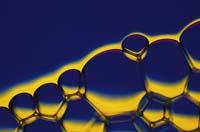Mathematics of Foam and Bubbles

Two theoretical mathematicians find a mathematical way to predict that bubbles forming foam will increase or decrease. In the case of two-dimensional foams, such as soap bubbles tight with two sheets, Neumann found that if the bubble has five or six sides it is reduced, if it has six it is maintained and if it has seven or more it is increased. This is 1952.
Since then, mathematicians have sought a similar standard for foam bubbles in three dimensions. Well, for this purpose he has offered them the mathematical concept which they call the characteristic of Euler; and Srolovitz and Macpherson have found this rule: in three-dimensional foam, a bubble will increase if the sum of the length of its edges is six times its average surface. Apparently, if this relationship is moved to two dimensions, the Neumann rule is achieved.
Buletina
Bidali zure helbide elektronikoa eta jaso asteroko buletina zure sarrera-ontzian











